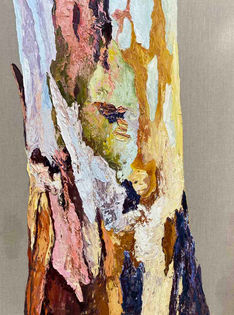ALL WORKS ARE OIL ON LINEN AND OIL ON CANVAS. FRAMED IN NATURAL OAK
ABOUT THE EXHIBITION
Australia’s iconic Eucalypts species takes centre stage in Sarah McDonald’s inaugural solo exhibition Come Closer and See at Canberra’s Grainger Gallery opening on the 29th April 2022. Featuring twenty paintings, the ubiquitous gum tree has been elevated to new heights with McDonald’s focus on the structure and surface of each individual tree’s bark, or as the artist herself calls it, the ‘skin’.
South Australia, where McDonald hails from, has a rich tradition of landscape painting, particularly with well-known and respected artist Sir Hans Heysen (1877-1968) whose landscape paintings feature gum trees, including trees around his beloved Cedars near Hahndorf. While Heysen’s paintings often use the gum tree as a compositional device in the scenic landscape painting tradition, McDonald has utilised a contemporary, almost abstracted style where the gum tree is the only subject: strongly cropped vertical compositions devoid of extraneous details such as leaves, twigs and soil, draws our attention to each tree’s individual characteristics: their marks, growths, indents and wrinkles. The gum tree literally is front and centre.
Inspired by the beauty of the seasonal changes apparent in various groups of gum trees that McDonald encounters on her daily walks, these trees have become familiar comforting presences in the artist’s life. As McDonald became more intrigued by the bark as it changed through the seasons, she began to research the biological processes of forests which deepened her understanding of not only the gum trees’ environmental importance but also the similarities to human social structures in the way forests support each other. McDonald began to realise these living entities are much more than simply grand, rustic beauties in our landscapes.
The sense of connection and love the artist feels for them has been imbued into this body of work with rich colour and texture and McDonald’s skill with the palette knife is evident in the way she has brought to life the texture of the bark, creating an almost three-dimensional surface rendered with luscious lashings of oil paint. Earthy greens, dusky pinks, soft blue-greys and light greys contrast with striking oranges and yellow greens, and deep burgundy reds and browns. Subtle passages of colour suggest bark ‘skins’ in various states of change. After the Rain We Shine 1 and After the Rain 2 feature a variety of deep sappy shapes contrasting against lighter parts of the bark and are reminiscent of Clyfford Still’s (1904-80) abstracted compositions with their organic shapes. The abstracted nature of this body of work is further heightened by McDonald’s elimination of all background details, with the canvas and linen left raw.
McDonald affection for her subject matter is not only evident in her application of paint, but also in the almost anthropomorphic approach she has adopted in titling the works with My Autumn Wardrobe, All Frocked Up, Jewels and All, and Loosening My Corset indicative of the artist’s emotional response to each gum tree as a unique entity with its own special characteristics. McDonald’s largest works (for example Aging Gracefully) are showstoppers, provoking the sense of scale, time, age and wonder that large established trees often do. But don’t be dissuaded in thinking this exhibition is about becoming a ‘tree hugger’ (although you just might feel like doing that after seeing these works), rather McDonald draws on a growing body of scientific evidence about the individual benefits of spending time in nature, such as ‘forest bathing’ (known as shinrin-yoku in Japan from where it originated). In respect to this, McDonald has transformed her very personal experiences into something we can all appreciate as Australians, and hopefully as citizens of the world; and in the age of climate change, there is perhaps nothing more important than protecting the lungs of our earth.
Come Closer and See asks us as viewers to do just that. To stop. To look. To reflect on the beauty, individuality and perhaps most importantly, the impact that these gentle giants of the plant world have in our lives and communities. And perhaps, maybe even inspire us to plant indigenous trees in our neighbourhood.
Text by Greta Laundy, 2022
.












































